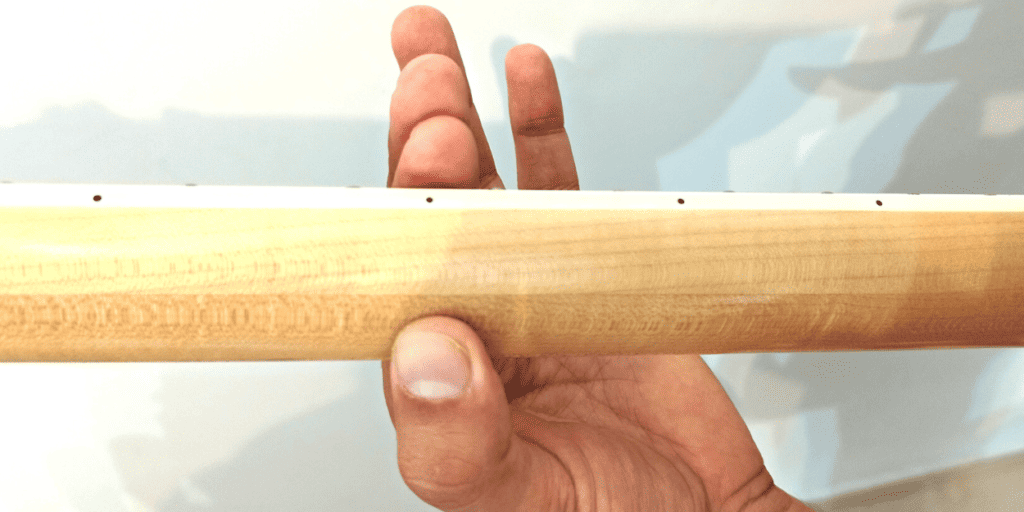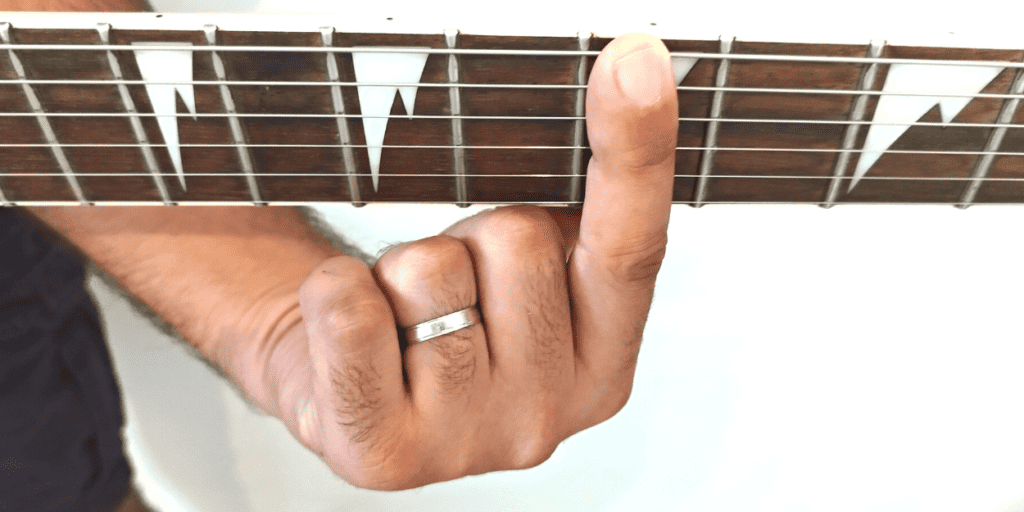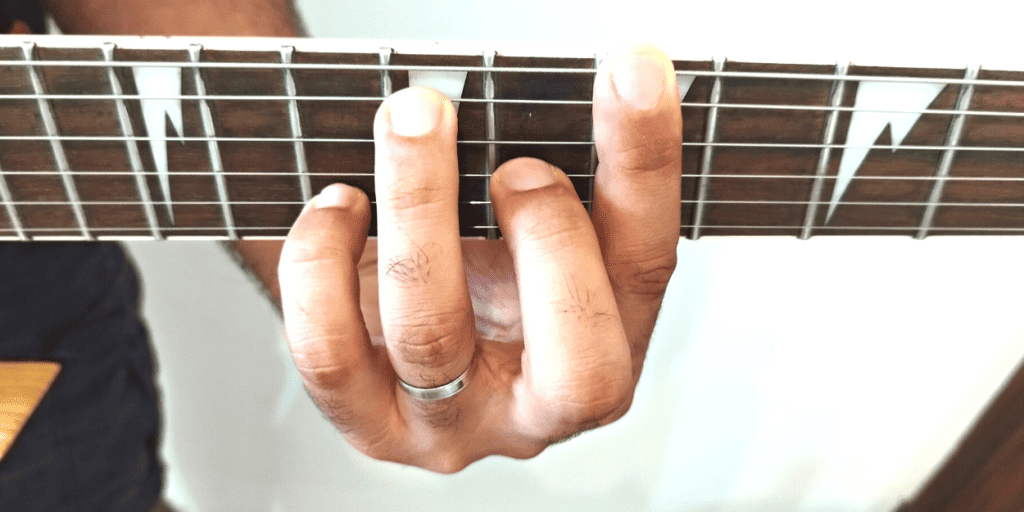Barre chords are an essential part of any guitarist’s vocabulary. They allow playing chords that can’t or are hard to play with open chords. They allow playing the same chord in different positions around the neck (saving some neck milage) and even playing songs in different keys without needing a capo.
This is a subject that the earlier you learn, the easier it is to accomplish, ideally right after you learn how to hold a pick and some basic guitar chords.
But what exactly are barre chords? In this article, we’ll answer that question while exploring their importance and helping you learn how to master them.
Table of Contents
What Are Barre Chords?
Barre chords can be considered the counterpart to open chords, the first few fundamental shapes taught when beginning guitar playing.
Open chords involve unfretted strings (no fingers on the fretboard). For example, when you play an E chord, your index, middle, and ring fingers press down on only three out of six strings (A, D, G).
The same principle repeats itself with most basic guitar chords.
While incredibly useful upon starting out, open chord voicings limit your ability if you want to take more advanced pieces featuring chords like Bm or F#m. Something not possible using just these basic forms alone.
This is where barre comes into play: by laying your index finger flat across all six strings like a “bar,” hence its name, you effectively create a “capo” that allows you to play any chord in different positions.
Why Should You Learn Barre Chords?
The ultimate benefit of learning barre chords is that they open up a new realm of possibilities for guitarists.
Through mastering this technique, players can explore various tonalities outside the standard open chords, allowing them to navigate complex progressions or create unique sounds within their own playing style.
Learning barres enhances your understanding of music theory as it requires utilization (and mastery) of fretboard navigation skills.
Is Learning Barre Chords Difficult?
Though challenging at first, developing one’s ability with barres brings immense rewards when applied correctly, so don’t be discouraged if you find yourself struggling initially!
As with all things musical, practice makes perfect, allowing eventually the user to feel comfortable navigating almost any song or performance situation imaginable using just their fingers rather than relying on an external device such as a capo.
With some determination and effort, anyone can start taking advantage of the flexibility offered by barre chords.
The Importance Of Good Technique
When attempting any type of physical activity involving repetition, such as playing guitar or sports training, good form is essential for optimal performance and avoiding injury.
This holds true especially so when dealing with complex movements like those involved while playing various styles on guitar, including learning how to skillfully play barre chords.
When facing difficulty with sounding clear or clean notes, the knee-jerk reaction may be to increase strength and press harder on the strings; however, this often leads to unwanted muscle fatigue and even injuries.
The answer is much simpler; focus firstly on proper finger, hand, and arm positioning in order to optimize technique. Mastering efficient form allows one to achieve beautiful sounds using only a fraction of the pressure that would otherwise have been used had poor form been employed.
7 Techniques For Mastering Barre Chords
In order for one’s techniques to become more effective when playing guitar, particularly barre chords, we recommend they adhere too:
1. Adjust Your Thumb Position
Achieving clean sound rests on properly positioning the thumb. Placing it too high or wrapping it around the neck won’t do much good.
The trick here is to align your thumb with either your index finger or somewhere between your index and ring fingers halfway down (or lower).
This brings the wrist closer to where it needs to be when executing barre chords correctly.

2. Utilize the Edge of the Index Finger
The flat face area of an index finger may not produce optimal results because its soft fleshiness makes pressing difficult while grooves catch strings easily; instead, use the edge of your index finger by pushing away towards the headstock, leveraging the harder outer part, reducing the pressure needed for crispness at the same time!
To ensure effective placement, close up near the fret. Make sure of parallel alignment so that it is not further from higher strings than low E strings either way; roll off the flat portion onto the edge before pushing.

3. Tuck in the Elbow
The elbow shouldn’t be sticking out like a chicken wing. Instead, it should hang naturally beside the body to make rolling and pushing away easier while maintaining comfort. This arm position allows for the proper execution of barre chords more readily as well.
4. Place Finger Close To Fret
To get sound without needing too much pressure/strength, utilize the spot nearest to the fret, align the index finger parallel with this point, then roll onto the edge mentioned previously.
Doing so instead of pressing down flat face works better results-wise; plus, less challenging physically speaking since effort is reduced & comfortable grip is achieved at the same time!

5. Keep Index Straight
In some cases, despite correct barring, strings are still mute due to a slightly arched index finger when playing; fix that by keeping completely straight throughout chord use (also low task joint between phalanx’s if not hearing B or high E string clearly).
A helpful approach is thinking about the hardest pressure being applied nearer the middle part, whereas the rest remains extended outward correctly, remaining flatly straightened all along the way.
6. Adjust the Placement Of the Index Finger
When one particular string mutes even though barred right, try moving your index finger slightly up/down from the fretboard; such alignment may resolve the issue.
7. Utilize Arm Strength
When your left-hand/thumb fatigue sets in during execution, arm strength comes into play; hug your instrument between the torso and right side while pulling backward with the same limb and add pressure to chords that way instead of depending solely on your thumb, which tires them out quicker.
To test progress, attempt playing a clear-sounding version without using your thumb. See how it goes, then!
Exercises For Mastering Barre Chords
Now that we have discussed the basics of barre chord technique let’s move on to some exercises which can help further enhance skills in this area:
1. Slapping The Strings With Your Index Finger
This technique may sound silly, but it’s actually incredibly useful!
To do this exercise, select any major or minor barre chord shape (for example, B Major on the 7th fret), then play it once to familiarize yourself with its sound.
Then slap each string individually, beginning from low E strings up to higher ones, G, B & E.
After you complete all 6 strings move down one fret position & repeat till you reach 1st while feeling comfortable; otherwise, stop if you feel muscle fatigue.
This will help enhance the clarity of played barres as well as awaken specific muscles in hands, which would get trained through consistency over time, becoming more adept at navigating different shapes faster & easier.
2. Programming the Shape Into Your Fingers
Forming & remembering barre chord shapes might be difficult for beginning guitarists, which is why this particular exercise can prove useful in establishing it as muscle memory.
Start by making an open E chord but without utilizing your index finger and play it to listen.
Does it sound correct or not? If yes, then press down firmly on all strings with pressure for 20 seconds (but take care not to push too hard).
Once you’ve done that, release the pressure and give your hand a rest, then repeat once or twice more until comfortable. Repeating gives your hands a better understanding of shapes they need to remember while playing different barres, thus improving the recognition process significantly when forming other chord shapes during practice sessions in future.
A similar approach applies to the A, Am, and Em shapes, and the C, D, Dm shape as well if desired.
3. Tracking Your Progress Exercise
This one focuses specifically on monitoring your own progress through technical exercises targeted towards mastering clarity, sounds & ultimately, consistency of played barres reliably over time.
To do so, begin at the 5th fret position, pressing down 6 strings with the index finger, followed by evaluating each individual chord to see if it sounds either clearly sounded out or muffled, followed by moving up one by one till you reach the 10th fret before returning back to 5th again.
Do the same exercise go downwards, trying to obtain at least 3 out of 6 strings sounding clear each time.
Overcoming Common Challenges
While mastering barre chords is a slow and arduous process facing any challenge head-on with confidence and determination will help you break through the wall of difficulty!
When becoming frustrated, just take it one step at a time while taking breaks if necessary; even experienced musicians have gone through such struggles before, so don’t give up.
With consistent practice combined with the right strategies, success can be achieved by unlocking new sonic possibilities across the entire fretboard.
Conclusion
Barre Chords may seem confusing at first, but by learning proper techniques coupled with correct exercises, one should not fear for too long!
Remember key points about thumb & elbow positioning, utilizing arm strength, finger placement, plus focusing only on specific strings required when playing barres, thus ensuring it has been set correctly or adjusted to create optimum conditions for maximum proficiency.
Embrace challenges met along your journey as opportunities that must be conquered rather than seen as roadblocks; soon enough, you’ll become an expert barer chord player experiencing the joy music mastery offers.